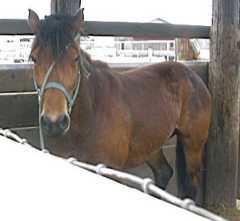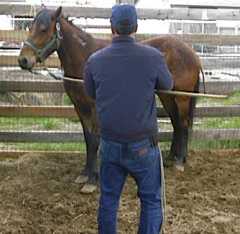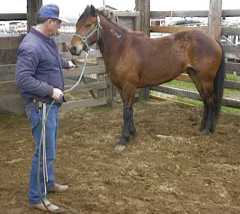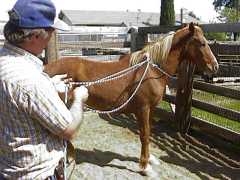Gentling with a
|
|
Important Note!
Some of these sequences were photographed decades ago before we participated in a helmet safety study. The results of the study were impressively conclusive. Since 1998 we always wear approved helmets when training and handling horses. |
|
With these seeds planted it's time to move on. If the horse has a halter and drag line, I'll use the pole to "fish" the lead over to me so I can hold it. Since the pole is no longer threatening, I can use it to grab the line, detangle it if it gets caught on the horse somehow, and do other things from a distance that I can't yet do up close. Depending on the horse, I may approach his nose or his shoulder. If I can approach the shoulder, I will resume scratching. If the horse is more comfortable presenting his nose, I'll let him smell the back of my hand, then rub the side of his lips with the back of my hand, eventually getting my hand turned over so I can massage his muzzle with my fingertips, poke my fingers into his mouth and rub his gums. At any point the horse may reach his threshold of tolerance. It's up to me to read the horse and back off before I unintentionally send him off. It's also up to me to be ready to take control of the horse's head (by the lead) if he does react so I can try to keep him facing me and also prevent the horse from presenting me with his back end. If the horse does manage to turn around on me, I'm not going to give a haul on him while I'm looking at his tail. So long as he thinks he can move forward and I'm not pursuing him, he's not too likely to try to kick me. However, if I go after him or try to shut him down, I'm asking for a shot from those hind feet. The pen is small enough that I can pay out some rope and reestablish control from a safer position. In the worst case, I can let go of the rope and pick it up again after things calm down. If the horse doesn't have a halter on, then I'll use the pole to get a sliding neck loop on him so we can proceed farther. |
With the horse desensitized to the
|
Press "Back" to return to the page that brought you hereGo to Case Study SectionReturn to Training SectionReturn to Wild Horse MentorsReturn to KBR World of Wild Horses and BurrosGo To
|




